We will put in a fix so it works when you replace “&&” with “\n”.
Posts made by info-creaticode
-
RE: custom 3d model animationsposted in Help
What kind of model and animation are you referring to? We’ll see what we can do about it.
-
RE: Newline?posted in Help
Which block are you using? Can you show your program or the project link?
-
RE: More camera stuffposted in Help
The canvas can’t be too big. It will be too slow. You can create multiple canvases and “stich” them together in your code.
-
RE: I need help with my chatting systemposted in Help
Can you try this example? It attaches the user’s avatar image as a costume, then uses that costume as the user icon in the chat:
-
RE: I have a questionposted in Help
Hi, the AI assistant for coding is called “XO”. See this post: https://www.forum.creaticode.com/topic/1093/creaticode-xo-ai-assistant-explain-to-me
Also, to create an AI player, you can use the AI blocks as the decision engine. Here is an example: https://www.forum.creaticode.com/topic/961/chatgpt-ai-who-s-the-spy-difficulty-3
-
RE: Regarding Creaticode's new "13+ Projects" featureposted in Feedback
The idea is to protect younger users. Here is some high level description:
https://www.forum.creaticode.com/topic/2448/13-projects
We agree plantz vs zombie games don’t have to be 13+
-
Dark mode is available nowposted in Announcements
To make our site more accessible, we have added the dark mode. You can turn it on/off this way:
-
Click on the top right dropdown under your user name, and select “Profile”
-
In the profile page, scroll down to the settings section, and toggle the “Dark Mode” button:
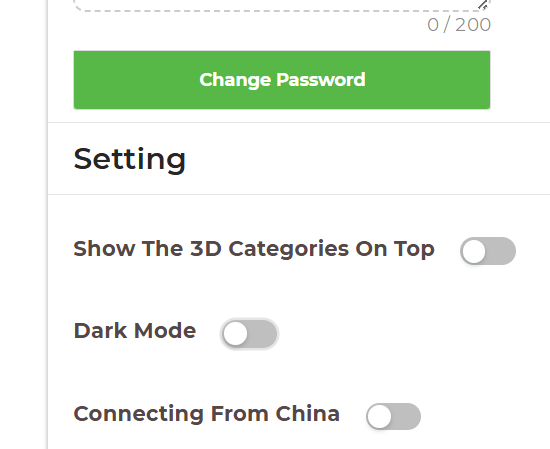
Here is what it looks like:

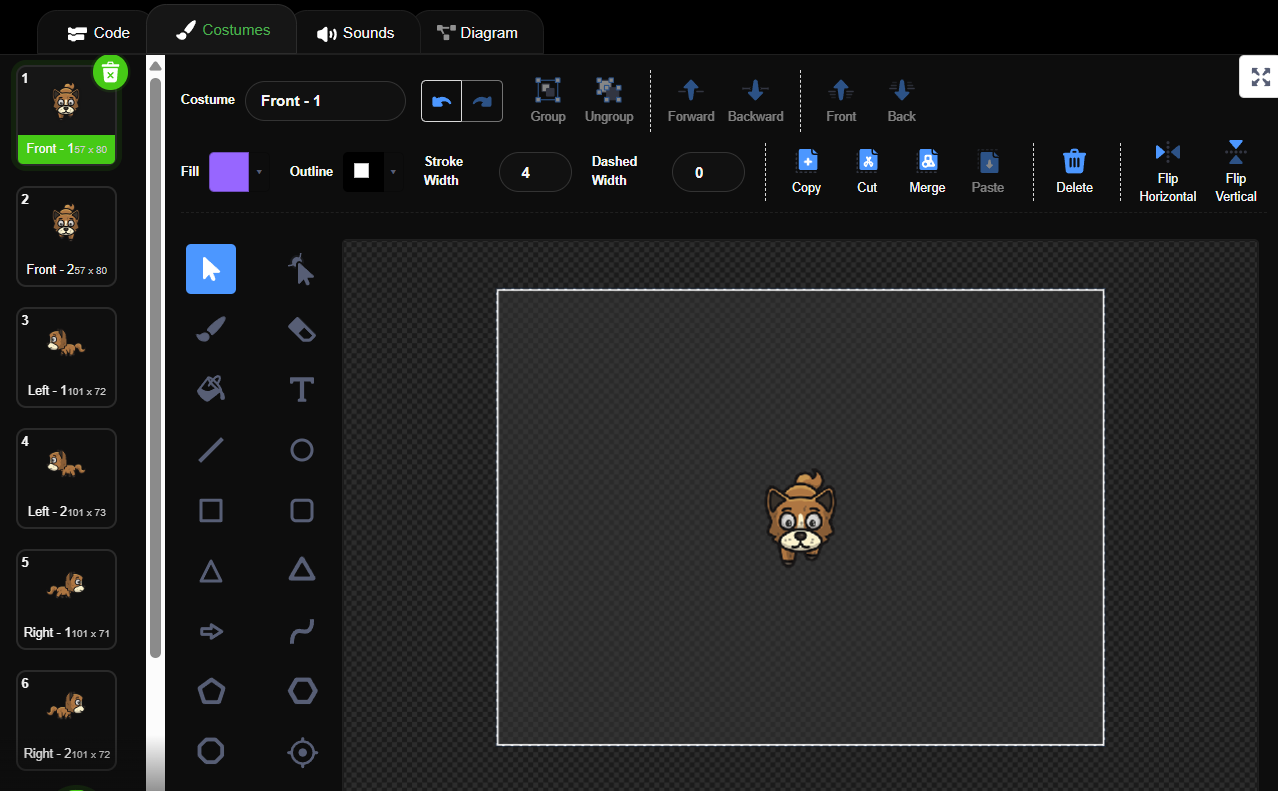
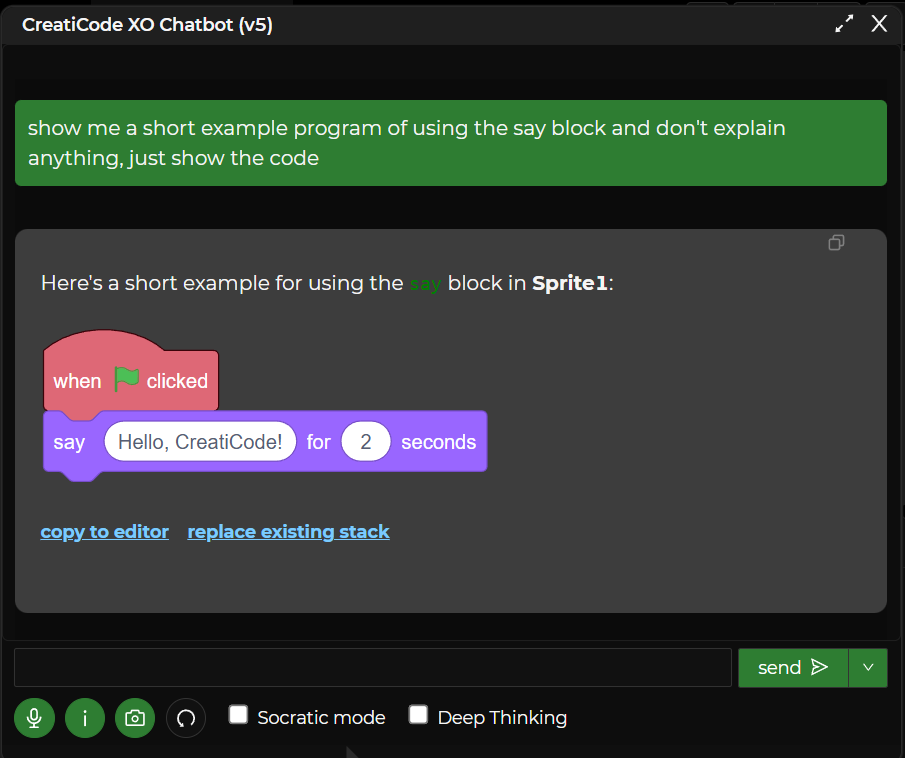

-
-
site being upgradedposted in Announcements
We are upgrading the site, it will be unavailable/non-stable for the next 30 minutes. Sorry.
-
2D Project Frame Rates Updateposted in Announcements
We have made some improvement in our game engine for 2D projects so that the frame rate will match that of MIT Scratch, rather than going too fast sometimes. Unfortunately, this means if you have intentionally added blocks to make the game loop slower, now your game would be too slow, so please remove such blocks. Thank you.
-
Sharing projects in class studiosposted in Tools
As a student of a class, you can easily share your projects in the class studio in the following steps.
Step 1 - Open the Class Page
After logging in, click the dropdown on the top right, and select “My Classes”:

Step 2 - Open the Studio Page
For the class you are currently enrolled, select the “studios” link under it:

In the list of studios, select the studio you would like to share your project in:
Step 3 - Add Your Project to the Studio
In the studio page, you will see your shared projects at the bottom under “Add My Shared Projects”, and you can click “Add +” on any of them to add to the studio:

-
13+ Projectsposted in Announcements
The CreatiCode platform serves two groups of users:
-
Young users (elementary school students) — similar to those on MIT Scratch, who enjoy fun, creative, and age-friendly projects designed to inspire imagination and introduce coding fundamentals.
-
Older users (middle and high school students) — who are more mature and can handle projects with complex storytelling, deeper emotional or philosophical themes, and mild suspense or darker tones, such as “Plants vs. Zombies”, “Tank war”, etc. These projects encourage critical thinking, creativity, and exploration of real-world ideas in a safe and respectful way.
To ensure that older users can freely share their creative work while keeping younger users protected, we’ve introduced a new feature in the Playground. When sharing or publishing a project, you can now mark it as “Meant for users 13 or older.”

If this box is checked, anyone who opens the project will first see a notice asking them to confirm that they understand the project is intended for older users:
When sharing a new project, please consider checking this box if your project might not be suitable for young users. If you see a project that should be marked as 13+ but it is not, please remind the author to do so in the comments, or report the project directly.
Please note that all shared projects must still be appropriate for school use, including those marked as 13+. Our administrators reserve the right to reclassify projects as 13+ or remove them if necessary. Users who share or publish inappropriate content risk permanent deletion of their accounts and projects without prior notice.
-
-
RE: Remote Edit for Projectsposted in Help
There was some issues. They are fixed now. Can you please refresh the webpage and try again?
-
RE: Server is not available for now due to upgradeposted in Announcements
The release is complete now.
-
Server is not available for now due to upgradeposted in Announcements
We are making a new release and we have to bring down the server for a while.
-
RE: Database problemposted in Help
The database blocks only work when you have signed in. We’ll look into enhancing it to work withou logging in.
-
RE: Re:5 new languages addedposted in General Discussion
We are still improving these 5 new languages. Will add more after they prove to be complete and correct.
-
RE: Possible hackerposted in Feedback
Geo info is a useful tool used by many apps, such as Google Maps or Uber. So getting the user’s location info itself is not a malicious behavior.
-
5 new languages addedposted in Announcements
Please do a hard reload to get the latest web page, and you will see 5 new languages. Please help us point out any translation issues. Thank you.

-
RE: Editor Very Laggyposted in Help
We added some new features to the editor, but they might have introduced some issues. Please reload to get the latest code, and if you still have trouble, please describe the issues. We will get them fixed quickly. thank you
-
RE: I love you creaticodeposted in Feedback
That’s already supporte for all users. Up to 6 users can work on the same project from their own computers:
-
RE: I love you creaticodeposted in Feedback
The “Add Friend” feature is still currently under development. Any interesting new feeatures that you would like to be enabled when 2 users are friends?
-
RE: Please add these languages over the next few months!posted in Feedback
We will take these into consideration.
-
RE: Can't see community 3d avatar modelsposted in Help
Since the models are uploaded by users, they may not be correctly created using ReadyPlayer.me. See https://www.forum.creaticode.com/topic/869/creating-your-own-avatar-using-readyplayer-me
But some of the avatar models are still usable. You would have to try them out to find which ones are usable. We will delete unusable avatar models over time.
-
RE: Costume Editor is very buggyposted in Help
@jamesa-blackwell-57b383d3 @DreamSMP_Luck
Please do a hard reload and try again. It should not automatically de-select the shapes any more.
-
RE: Costume Editor is very buggyposted in Help
Sorry about the issues. We will look into them and fix it.
-
RE: Can't see community 3d avatar modelsposted in Help
When you say “can’t see”, do you mean you can load them or you can’t see any model in the library?
If you mean you can’t load them, do you mean you can’t load any of them or some of these community avatar modesl?
An example project to reproduce the issue would be helpful for us to investigate. thank you.
-
RE: Sprites won't appear on project from backpackposted in Help
Can you please share the project link?
Also, for now, can you export the sprite and the import it?
-
RE: Clear prints buttons don't work againposted in Feedback
Can you please share the project link? We will look into why it crashes.
-
RE: Clear prints buttons don't work againposted in Feedback
Please use the draw and clear blocks in the “Pen” category for now.
-
RE: How to add a code snippet?posted in General Discussion
You can right click on any sprite and select share. Please make sure the code in that sprite is serving one purpose so it is reusable by others.
-
Generate Vector Images Using AIposted in Tutorials
Image Formats: Vector vs Bitmap
In Scratch, a costume image can be a “bitmap” or a “vector” format:- Bitmap images are stored as a matrix of small square boxes called “pixels”
- Vector images are stored as a few shapes, where each shape is represented by its outline and fill colors.
You can easily tell the difference when you zoom in an image:
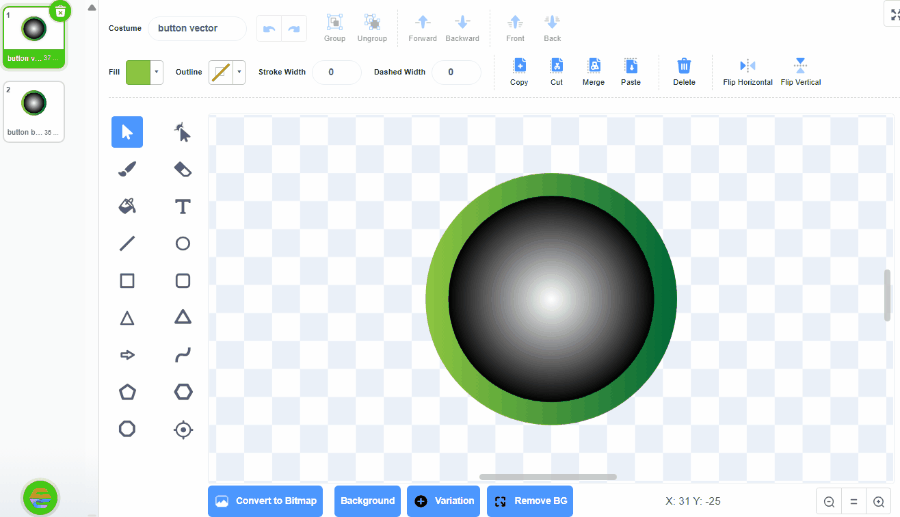
There are several important benefits when we use a vector image:
First, vector images will always look the same when you scale them up, but bitmap images look worse due to lower resolution when you switch to full screen mode.
Second, a vector image’s file size is usually much smaller than a bitmap for the same content. For example, imagine we need to draw a big square. In bitmap format, we need to specify every pixel’s color, but in vector format we only need to specify the edge length and one color. Therefore, if your project would run faster and smoother when you use vector images
Third, vector images are much easier to modify. Since it is composed of individual shapes, you can move/resize/recolor each shape without affecting other parts of the image.
Note that the vector format is not always better. If the image has a lot of details, then the bitmap format should used. For example, if almost every pixel in the image has different colors, then there is no easy way to describe it using simple shapes in the vector format, and we should just store each pixel’s information using the bitmap format.In summary, choose the vector format if the image is made of a few simple shapes in uniform or gradient colors.
How to Generate a Vector Image Using AI
On MIT Scratch, there are only a limited number of vector images from the library. On CreatiCode, you can use AI to generate new vector images based on your project. The basic idea is to generate a bitmap image using AI, then convert it to a vector format using another AI tool.
Below are the steps:
Step 1 - Generate a bitmap image
As shown, you can start by selecting the “AI” tool for adding a sprite.
In the input box, describe the object, specify it is a vector image, and then click “generate”. For example:

Important notes:
-
This AI tool can only generate images in the bitmap format, even if our prompt says “vector image”. It will try to generate an image that looks like a typical vector image (a few shapes of simple colors)
-
The prompt must contain the keyword “vector” to ensure the AI generates an image in this style. You can add additional instructions to further emphasize this, such as “with simple shapes”, “flat vector illustration”, “for costumes in MIT Scratch”, etc.
-
You might need to refine the description or regenerate the image.
Once you have the image you like, click on it to add it as a new costume.
Step 2 - Clean up the costume image (optional)
The costume will be in bitmap format. Before converting it to a vector image, you might need to clean it up.
For example, the image may contain a shadow. You can use the erazer tool to remove it manually, or use the new magic wand tool to select and delete it.
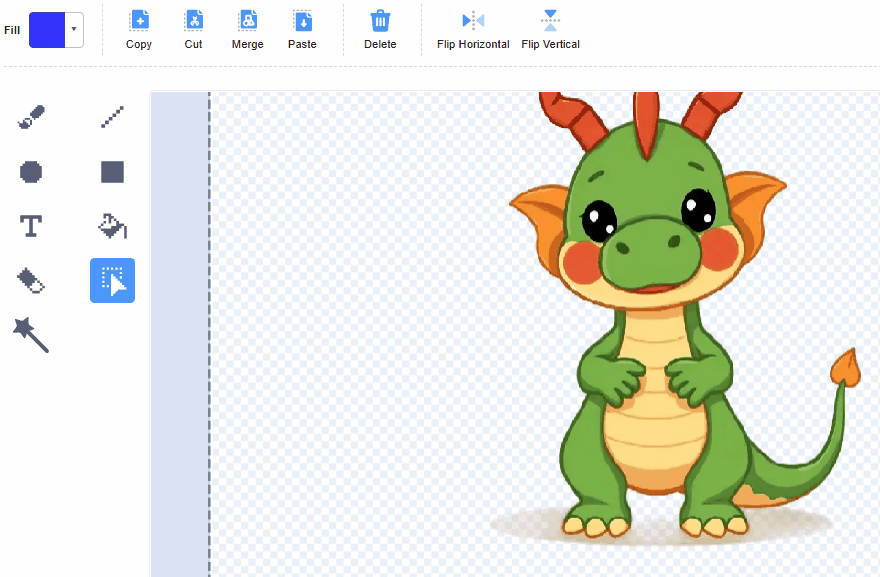
For another example, sometimes the AI generated image has some transparent parts. You can use the “fill” tool to fill some colors in there.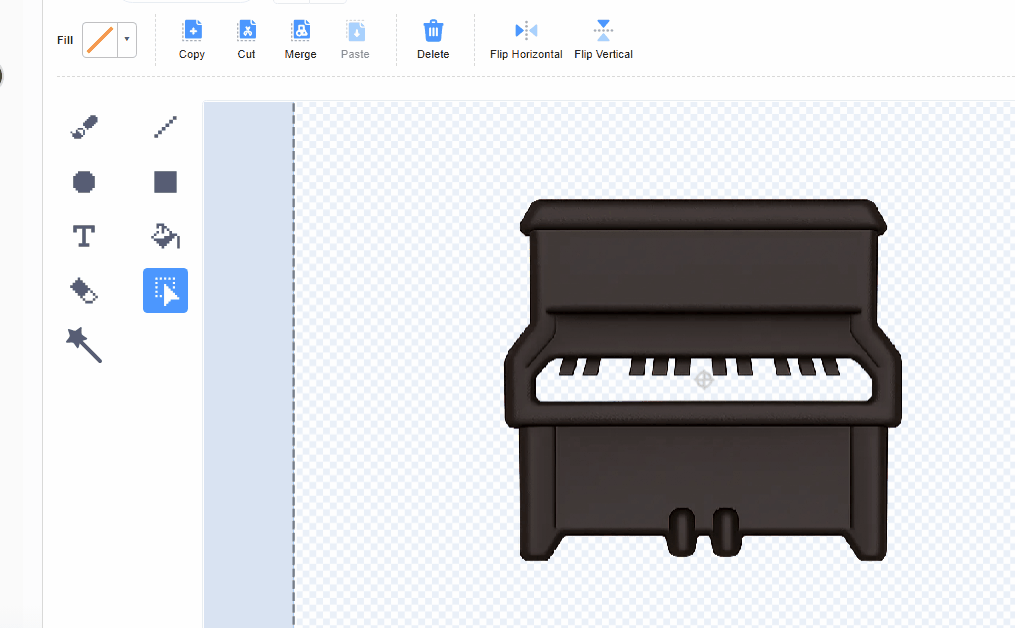
Step 3 - Convert the bitmap costume to a vector image
You can click the “Vectorize” button to convert any bitmap costume to a new vector costume:

A new vector format costume will be added, and the original bitmap costume is not changed. This is a true vector image, as you can select individual parts and change them:
Note that the original MIT Scratch provides a button to convert a bitmap image to vector, but it is not really a true vector image. It only represents the entire image as one big shape, and you still can’t edit individual parts.
Create Vector Images from Drawings
Since you can convert any bitmap costume to a vector costume, you can also draw a costume of your own, then convert it.
For example, suppose we use a few simple shapes to create a small house, and then use the “variations” tool to convert it to a cartoon:
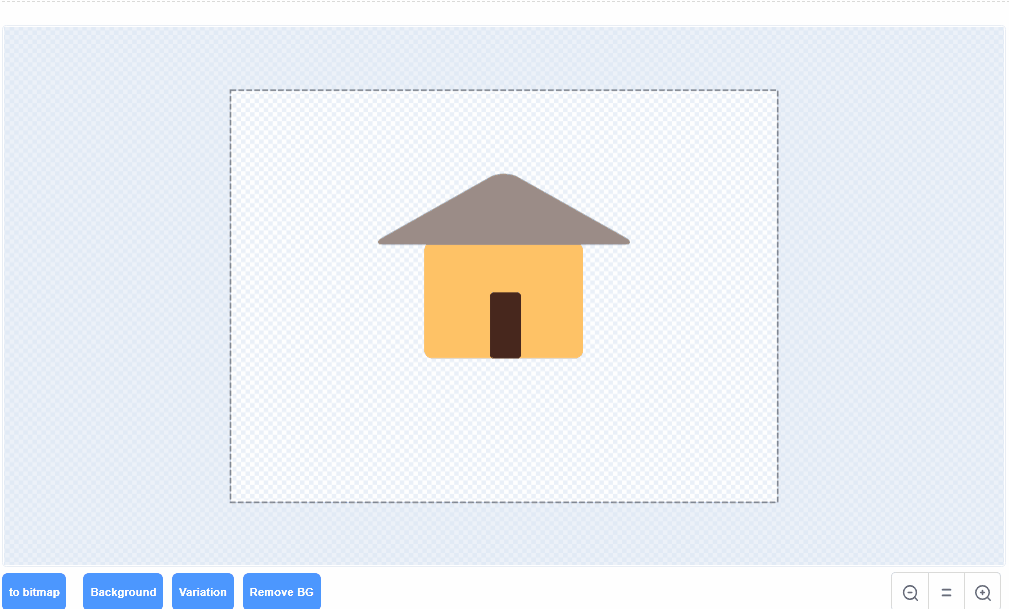
Next, we can convert this cartoon house to a vector image. Note that it needs to be in the “bitmap” mode first, since the “vectorize” button is only available in the bitmap mode:
Search for Vector Images
The vector images generated by any user is shared with the community. You can open the AI image tool for sprites (not backdrops), and select the “Vector” type to search for them:

-
RE: Weird bug in Creaticodeposted in Feedback
This seems to be caused by the new buttons we added at the bottom of the costume editor, which takes too much space. We will fix this ASAP.
-
RE: isn't there a way to upload scratch games to here by only having a link?posted in Help
This button is also available in the My Stuff page now

Also, it will automatically quote the original project for credits.
-
RE: The ia moderation is broken ?posted in Feedback
Please reload the playground. Now the moderation is more accurate.
